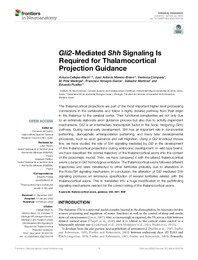Por favor, use este identificador para citar o enlazar este ítem:
https://hdl.handle.net/11000/31170Registro completo de metadatos
| Campo DC | Valor | Lengua/Idioma |
|---|---|---|
| dc.contributor.author | Callejas Marín, Antuca | - |
| dc.contributor.author | Moreno Bravo, Juan Antonio | - |
| dc.contributor.author | Company Devesa, Verónica | - |
| dc.contributor.author | Madrigal Verdú, María del Pilar | - |
| dc.contributor.author | Almagro García, Francisca de Paula | - |
| dc.contributor.author | Martínez Pérez, Salvador | - |
| dc.contributor.author | de Puelles Martínez de La Torre, Eduardo | - |
| dc.contributor.other | Instituto de Neurociencias | es_ES |
| dc.contributor.other | Departamentos de la UMH::Patología y Cirugía | es_ES |
| dc.contributor.other | Departamentos de la UMH::Histología y Anatomía | es_ES |
| dc.date.accessioned | 2024-02-06T17:17:57Z | - |
| dc.date.available | 2024-02-06T17:17:57Z | - |
| dc.date.created | 2022-02 | - |
| dc.identifier.citation | Frontiers in Neuroanatomy 2022 Feb 10:16:830758 | es_ES |
| dc.identifier.issn | 1662-5129 | - |
| dc.identifier.uri | https://hdl.handle.net/11000/31170 | - |
| dc.description.abstract | The thalamocortical projections are part of the most important higher level processing connections in the vertebrates and follow a highly ordered pathway from their origin in the thalamus to the cerebral cortex. Their functional complexities are not only due to an extremely elaborate axon guidance process but also due to activity-dependent mechanisms. Gli2 is an intermediary transcription factor in the Sonic hedgehog (Shh) pathway. During neural early development, Shh has an important role in dorsoventral patterning, diencephalic anteroposterior patterning, and many later developmental processes, such as axon guidance and cell migration. Using a Gli2 knockout mouse line, we have studied the role of Shh signaling mediated by Gli2 in the development of the thalamocortical projections during embryonic development. In wild-type brains, we have described the normal trajectory of the thalamocortical axons into the context of the prosomeric model. Then, we have compared it with the altered thalamocortical axons course in Gli2 homozygous embryos. The thalamocortical axons followed different trajectories and were misdirected to other territories probably due to alterations in the Robo/Slit signaling mechanism. In conclusion, the alteration of Gli2-mediated Shh signaling produces an erroneous specification of several territories related with the thalamocortical axons. This is translated into a huge modification in the pathfinding signaling mechanisms needed for the correct wiring of the thalamocortical axons | es_ES |
| dc.format | application/pdf | es_ES |
| dc.format.extent | 13 | es_ES |
| dc.language.iso | eng | es_ES |
| dc.publisher | Frontiers Media [Commercial Publisher] | es_ES |
| dc.rights | info:eu-repo/semantics/openAccess | es_ES |
| dc.rights.uri | http://creativecommons.org/licenses/by-nc-nd/4.0/ | * |
| dc.subject | Gli2 | es_ES |
| dc.subject | Slit1 | es_ES |
| dc.subject | Slit2 | es_ES |
| dc.subject | guidance | es_ES |
| dc.subject | thalamocortical axons | es_ES |
| dc.title | Gli2-Mediated Shh Signaling Is Required for Thalamocortical Projection Guidance | es_ES |
| dc.type | info:eu-repo/semantics/article | es_ES |
| dc.relation.publisherversion | https://doi.org/10.3389/fnana.2022.830758 | es_ES |

Ver/Abrir:
Gli2-Mediated Shh Signaling Is Required for Thalamocortical Projection Guidance.pdf
6 MB
Adobe PDF
Compartir:
 La licencia se describe como: Atribución-NonComercial-NoDerivada 4.0 Internacional.
La licencia se describe como: Atribución-NonComercial-NoDerivada 4.0 Internacional.
.png)